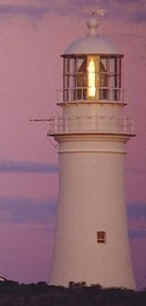
Story and images
Copyright © 2003 Garry Searle
Image of the lighthouse c1985
© David
Miller

Page 6
![]() 6:30 already, and still jobs to do before we relaxed. I went inside and started the small gas-fridge. Dave switched on the battery banks, solar-recharged by day, these once supplied power to the main light. Next to be checked was water, and we found that Cottage 1, where we would be cooking and where the majority of us would be sleeping and showering, had no water. A check of the tanks and lines showed nothing out of place. There are several tanks holding the supply, and a pump feeds the water to an above ground tank which gravity feeds to the cottage. Cottage 2 has an above ground tank, so it would provide our needs for tonight, and this would become the priority tomorrow morning. We take so many things for granted, we turn on a tap, flick a switch. If nothing this week would be a reality check... an appreciation of the conveniences our modern world offers yet are taken for granted.
6:30 already, and still jobs to do before we relaxed. I went inside and started the small gas-fridge. Dave switched on the battery banks, solar-recharged by day, these once supplied power to the main light. Next to be checked was water, and we found that Cottage 1, where we would be cooking and where the majority of us would be sleeping and showering, had no water. A check of the tanks and lines showed nothing out of place. There are several tanks holding the supply, and a pump feeds the water to an above ground tank which gravity feeds to the cottage. Cottage 2 has an above ground tank, so it would provide our needs for tonight, and this would become the priority tomorrow morning. We take so many things for granted, we turn on a tap, flick a switch. If nothing this week would be a reality check... an appreciation of the conveniences our modern world offers yet are taken for granted.

![]() With the basic necessities checked and running, and some time to myself, I headed to the light tower, stopping several metres away and staring upward, regretting that I was not able to catch a glimpse of the huge 'fresnel' lens that once filled the lantern room. These glass structures, named after the French Physicist Augustine Fresnel, who invented the lens in 1822, revolutionised lighthouse technology around the world. With up to 1,000 individual glass prisms mounted in a brass fixture, they can stand over 3 metres tall and 2 metres in diameter. Large enough for a man to stand inside, they are a magnificent sight. Automation in 1991 saw the original lens replaced with a small 'plastic' unit, just a foot in diameter. It looked so out of place, perched in the centre of the empty lantern room.
With the basic necessities checked and running, and some time to myself, I headed to the light tower, stopping several metres away and staring upward, regretting that I was not able to catch a glimpse of the huge 'fresnel' lens that once filled the lantern room. These glass structures, named after the French Physicist Augustine Fresnel, who invented the lens in 1822, revolutionised lighthouse technology around the world. With up to 1,000 individual glass prisms mounted in a brass fixture, they can stand over 3 metres tall and 2 metres in diameter. Large enough for a man to stand inside, they are a magnificent sight. Automation in 1991 saw the original lens replaced with a small 'plastic' unit, just a foot in diameter. It looked so out of place, perched in the centre of the empty lantern room.
The Lighthouse tower
c1985 showing the
1st order Fresnel lens
© David
Miller
![]() I walked the remaining steps to the tower and placed my hands on the cold
white-painted stone, a ritual that is always a part of my lighthouse
visits. To me these structures seem to live and breathe. So much history,
so many memories of the people that built and worked at these isolated
outposts. I try and gain a perspective of what it was like 150 years ago.
No electricity, no planes, no telephone... what a great achievement the
construction must have been. The life stories of the keepers, their wives
and children, who spent months at a time with no contact to the outside
world. Stories of hardship, loneliness and often sorrow, as these
dedicated families lived and sometimes died, offering safety and a
comforting light to the ships which were, at that time, our only means of
trade and transportation.
I walked the remaining steps to the tower and placed my hands on the cold
white-painted stone, a ritual that is always a part of my lighthouse
visits. To me these structures seem to live and breathe. So much history,
so many memories of the people that built and worked at these isolated
outposts. I try and gain a perspective of what it was like 150 years ago.
No electricity, no planes, no telephone... what a great achievement the
construction must have been. The life stories of the keepers, their wives
and children, who spent months at a time with no contact to the outside
world. Stories of hardship, loneliness and often sorrow, as these
dedicated families lived and sometimes died, offering safety and a
comforting light to the ships which were, at that time, our only means of
trade and transportation.